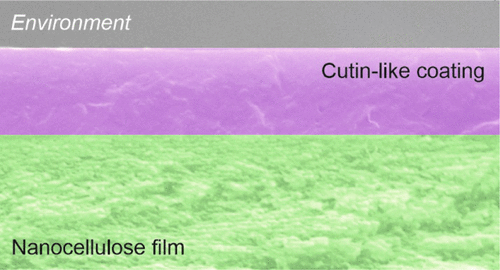当前位置:
X-MOL 学术
›
ACS Appl. Polym. Mater.
›
论文详情
Our official English website, www.x-mol.net, welcomes your feedback! (Note: you will need to create a separate account there.)
Plant-Inspired Polyaleuritate–Nanocellulose Composite Photonic Films
ACS Applied Polymer Materials ( IF 5 ) Pub Date : 2020-03-06 , DOI: 10.1021/acsapm.9b01205 José A. Heredia-Guerrero 1, 2 , Cyan A. Williams 3 , Giulia Guidetti 3 , Pietro Cataldi 1, 4 , Luca Ceseracciu 5 , Doriana Debellis 6 , Athanassia Athanassiou 1 , Susana Guzman-Puyol 1, 2 , Wadood Y. Hamad 7 , Silvia Vignolini 3
ACS Applied Polymer Materials ( IF 5 ) Pub Date : 2020-03-06 , DOI: 10.1021/acsapm.9b01205 José A. Heredia-Guerrero 1, 2 , Cyan A. Williams 3 , Giulia Guidetti 3 , Pietro Cataldi 1, 4 , Luca Ceseracciu 5 , Doriana Debellis 6 , Athanassia Athanassiou 1 , Susana Guzman-Puyol 1, 2 , Wadood Y. Hamad 7 , Silvia Vignolini 3
Affiliation

|
Plant epidermis is a complex composite material composed of the cuticle and epidermal cells. In order to prevent dehydration, the cuticle, a water barrier composed of an outer layer (proper cuticle) connected to the cell wall of the epidermal cells via a complex matrix often referred to as cutinized cell wall, acts as a compatibilizer for water-repellent cutin and the hydrophilic polysaccharides in the cell walls. Here, biomimetic plant epidermis-inspired films with selective reflection properties were prepared by the formation of an aliphatic polyester coating on chiral nematic cellulose nanocrystal (CNC) films. Aleuritic acid, a polyhydroxylated fatty acid, was sprayed on CNC films and polymerized by hot-pressing. The micromorphology of the resultant samples was characterized by scanning electron microscopy. Polarized optical microscopy confirmed the CNC helicoidal organization in the films, responsible for the reflection of circularly polarized light, before and after hot-pressing. The chemical analysis by attenuated total reflection-Fourier transform infrared spectroscopy confirmed the polymerization of aleuritic acid into polyaleuritate with differences between filter paper and wood pulp substrates that were ascribed to water elimination during polycondensation. The characterization of the mechanical (Young’s modulus and hardness from nanoindentation tests) and hydrodynamic (water uptake and water vapor transmission rate) properties indicated that this process enhances the robustness and waterproof behavior of CNC films. These properties were comparable to those of commercial and biodegradable materials commonly used in packaging such as polyesters and cellulose derivatives, thus making these natural composites ideal for optically responsive packaging applications.
中文翻译:

植物启发性多铝酸酯-纳米纤维素复合光子膜
植物表皮是由表皮和表皮细胞组成的复杂复合材料。为了防止脱水,由外部层(适当的表皮)构成的防水层通过通常被称为角质化细胞壁的复杂基质连接至表皮细胞的细胞壁,该表层用作疏水性的增容剂。角质和细胞壁中的亲水性多糖。在这里,通过在手性向列纤维素纳米晶体(CNC)膜上形成脂族聚酯涂层,制备具有选择性反射特性的仿生植物表皮启发性膜。将多羟基化脂肪酸阿魏酸喷涂到CNC薄膜上,并通过热压聚合。所得样品的微观形貌通过扫描电子显微镜表征。偏光光学显微镜证实了薄膜中的CNC螺旋结构,其在热压之前和之后负责反射圆偏振光。通过衰减全反射-傅立叶变换红外光谱进行的化学分析证实,在滤纸和木浆基材之间存在差异的原因是缩聚过程中水分消除,从而使醛酸聚合成多醛酸酯。力学性能(纳米压痕试验的杨氏模量和硬度)和流体动力学(吸水率和水蒸气透过率)的特性表明,该过程增强了CNC薄膜的坚固性和防水性能。
更新日期:2020-04-23
中文翻译:

植物启发性多铝酸酯-纳米纤维素复合光子膜
植物表皮是由表皮和表皮细胞组成的复杂复合材料。为了防止脱水,由外部层(适当的表皮)构成的防水层通过通常被称为角质化细胞壁的复杂基质连接至表皮细胞的细胞壁,该表层用作疏水性的增容剂。角质和细胞壁中的亲水性多糖。在这里,通过在手性向列纤维素纳米晶体(CNC)膜上形成脂族聚酯涂层,制备具有选择性反射特性的仿生植物表皮启发性膜。将多羟基化脂肪酸阿魏酸喷涂到CNC薄膜上,并通过热压聚合。所得样品的微观形貌通过扫描电子显微镜表征。偏光光学显微镜证实了薄膜中的CNC螺旋结构,其在热压之前和之后负责反射圆偏振光。通过衰减全反射-傅立叶变换红外光谱进行的化学分析证实,在滤纸和木浆基材之间存在差异的原因是缩聚过程中水分消除,从而使醛酸聚合成多醛酸酯。力学性能(纳米压痕试验的杨氏模量和硬度)和流体动力学(吸水率和水蒸气透过率)的特性表明,该过程增强了CNC薄膜的坚固性和防水性能。



























 京公网安备 11010802027423号
京公网安备 11010802027423号